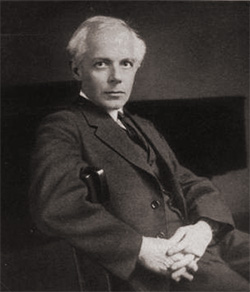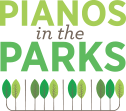Béla Bartó
| Born |
Béla Viktor János Bartók
25 March 1881 Nagyszentmiklós, Kingdom of Hungary, Austria-Hungary
|
|---|---|
| Died | 26 September 1945 (aged 64)
New York City, U.S.
|
| Occupation(s) | composer, pianist and ethnomusicologist |
| Works | List of compositions |
Bartók was born in the Banatian town of Nagyszentmiklós in the Kingdom of Hungary (present-day Sânnicolau Mare, Romania) on 25 March 1881. On his father’s side, the Bartók family was a Hungarian lower noble family, originating from Borsodszirák, Borsod.His paternal grandmother was a Catholic of Bunjevci origin, but considered herself Hungarian.Bartók’s father (1855–1888) was also named Béla. Bartók’s mother, Paula (née Voit) (1857–1939), spoke Hungarian fluently.
See More :
- Friedrich Baumfelder
- Ludwig van Beethoven
- Mily Alexeyevich Balakirev
- Ferdinand Beyer
- Luigi Boccherini
Béla Bartók (1881-1945) was born in the small provincial town of Nagyszentmiklós, then Hungary (now Sânnicolau Mare in Romania). He received his first piano lessons from his mother, and showed great talent already at four years of age. He later studied piano and composition at the Budapest Royal Academy of Music. In 1902 he met Richard Strauss at the Budapest premiere of Also sprach Zarathustra, and about one year later Bartók´s own grandiose and nationalistic tone poem Kossuth was premiered.

By this time, Bartók was also a renowned piano virtuoso, travelling abroad performing music of Liszt and other romantic composers. But when he became professor of piano at the Budapest Royal Academy, he more or less abandoned this career and spent more time composing and collecting folk songs from different parts of the world. Together with fellow composer Zoltan Kodály, he had systematically been collecting and recording Hungarian folk music, and now he went on to visit Turkey and parts of North Africa. In spite of Bartók’s preoccupation with Hungarian folk music, his work was at not at all appreciated by his own people. In the rest of Europe, however, his fame was rising quickly. Apart from the influence of folk music and the romantic heritage from Liszt and Brahms,
Bartók also adapted for his own purposes the methods of his contemporaries Strauss, Debussy and Stravinsky. All these elements combine to make his output extremely varied, vital and forceful, melodically and rhythmically. More than a quarter of Bartók’s output was for the piano. His educational work Mikrokosmos progresses from the very simple to the highly demanding, and explores almost all aspects of the piano’s potential.
The events of World War II forced Bartók to flee Hungary and emigrate to the USA. The fact that he was relatively unknown in this country, together with his failing health and a difficult financial situation, made Bartok´s last years unhappy. In 1945 he died of leukemia and was buried in New York. After the fall of Hungarian communism in 1988, his remains were transferred to Budapest to be given a full state funeral.
All pieces: |
||||
|---|---|---|---|---|
Romanian Folk Dances |
||||
| 1. Stick Game | A Minor | 1915 | 5 | |
| 2. Peasant Costume | D Minor | 1915 | 2 | |
| 3. Standing Still | B Minor | 1915 | 5 | |
| 4. Song of the Mountain Horn | A Minor | 1915 | 4 | |
| 5. A Garden Gate in Romania | D Major | 1915 | 5 | |
| 6. Little One | D Major | 1915 | 6 | |
Etudes Op. 18 |
||||
| 1. Etude: Allegro molto | N/A | 1920 | 8+ | |
| 2. Etude: Andante sostenuto | N/A | 1920 | 8+ | |
| 3. Etude: Rubato | N/A | 1920 | 8+ | |
Miscellaneous pieces |
||||
| Allegro Barbaro | N/A | 1911 | 8+ | |
| Suite Op. 14 | N/A | 1918 | 8 | |
Source by: pianosintheparks.com



Leave a Reply
Want to join the discussion?Feel free to contribute!